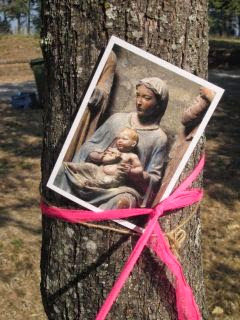Not that I am a lavoir expert, or lavoirologist,
to coin a fresh bit of jargon which will never be used outside the context of this blog,
this is the first lavoir I have seen with a built-in fireplace.
How highly sensible and civilised.
And I wonder about the politics behind this token of luxury, for certainly,
washing clothes goes under the generic term "women's work".
Shattering the ice on a bucket of soaking nappies isn't my idea of a holiday
although it had to be done a few times in my rugged, ethnic small-holder past.
And like millions of other women over the millennia, I survived to tell the tale,
in word and by the sorry state of my over used hands.
Like most lavoirs, this one was empty yet well maintained.
The clear, still water caught the sunlight and threw reflections across the walls.
Les Penitents
The peculiar conclomerate rock which forms the Penitents is approximately 25 million years old, however the Penitents themselves are relatively modern, only 3 millions old and formed mostly through erosion, runoff, and the River Durance eating its way to the sea. The towers are between 800-1200 meters tall.
The legend of these formations is a bit convoluted and tricky
to understand in its computer generated translation.
The long and the short of it is (maybe): there was a moonlit Saracen invasion and Rimbaud, a noble knight, came to defend the land. However he found himself not with a hoard of marauders, but with seven Moorish women "with beautiful black eyes" "who revived in him very human passions."
St. Donnat the Hermit got jealous and turned them all into stone.
Whether this is an example of historical graffiti illustrating these "very human passions",
I would not like to say.
I would not like to say.
Later, I passed the lavoir on my way back to the campsite.
The was my first experience of a lavoir in use.
The was my first experience of a lavoir in use.
The man lifted an enormous teddy bear out of the water.
It was obvious by his stance that he found it surprisingly heavy.
His daughter stamped about in the newly formed puddles squealing with delight.
It was obvious by his stance that he found it surprisingly heavy.
His daughter stamped about in the newly formed puddles squealing with delight.
Then they massaged him with a bar of soap before setting to with their scrub brushes.
In 1954, an electric animation of Mees was installed in a side chapel of the church.
A very loud motor which overheats quickly and smells of burning bakolite and sewing machine oil powers a parade of women going to market, shepherds with their sheep, gypsies with babies tied to their backs beating tambourines, pipers, old men leaning on sticks etc etc along a four tiered track.
Behind the village loom the Penitents.
One of the women cleaning the church, put her dusting cloth down and
proudly pressed the start button and the little figures jerked into action.
She shouted over the noise and I nodded without understanding a word of what she said.
One of the women cleaning the church, put her dusting cloth down and
proudly pressed the start button and the little figures jerked into action.
She shouted over the noise and I nodded without understanding a word of what she said.

















